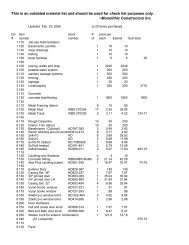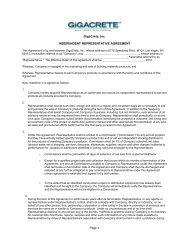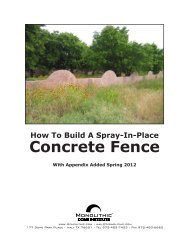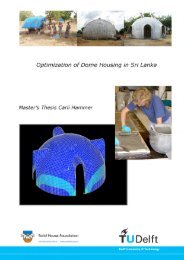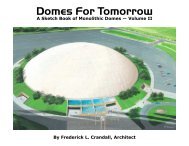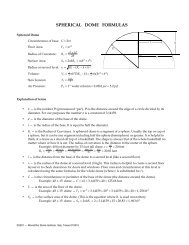Literature Review on Building Envelope, Heating and ... - Beeshive.org
Literature Review on Building Envelope, Heating and ... - Beeshive.org
Literature Review on Building Envelope, Heating and ... - Beeshive.org
You also want an ePaper? Increase the reach of your titles
YUMPU automatically turns print PDFs into web optimized ePapers that Google loves.
• Incorporate expansi<strong>on</strong> joints to compensate for structural movement due to large<br />
temperature variati<strong>on</strong>s from winter to summer.<br />
• Install triple-glazing, low-e coating windows with insulated fibre reinforced plastic<br />
frames.<br />
• Avoid stepped roofs, offsets, nooks, or parapet walls to prevent the accumulati<strong>on</strong> of<br />
snowdrifts. Use a sloping roof secti<strong>on</strong> to c<strong>on</strong>nect two roof levels. Metal roofing has<br />
performed satisfactorily. Skylights are not recommended unless designed to c<strong>on</strong>trol<br />
c<strong>on</strong>densati<strong>on</strong>. Eaves minimum projecti<strong>on</strong>s are 200 to 600 mm (8 to 24 in.) below the<br />
tree line <strong>and</strong> 100 to 200 mm (4 to 8 in.) above the tree line. Below the tree line,<br />
ventilated roof systems perform well. Above the tree line, roof venting is problematic.<br />
It is difficult to avoid snow infiltrati<strong>on</strong> through vents. Incorporate drains for melted<br />
snow.<br />
• Incorporate strategies to minimize the impact of the building <strong>on</strong> the thermal<br />
equilibrium of the permafrost <strong>and</strong> also to reduce snowdrift accumulati<strong>on</strong>. A comm<strong>on</strong><br />
strategy is elevating the building about 0.9 to 1.2 m (3 to 4 ft.) above the ground. A<br />
Swedish study c<strong>on</strong>cluded that a 1.8 m (6 ft.) elevati<strong>on</strong> worked well in Antarctica.<br />
• In winter, strategies to harness any daylight available include large windows,<br />
clerestory windows, <strong>and</strong> strategically placed skylights to allow natural light to<br />
penetrate into living spaces. In summer, latticed window screens block the c<strong>on</strong>tinual<br />
oblique rays. Scale <strong>and</strong> spacing of the slats of window shading devices may be<br />
optimized using solar angle calculati<strong>on</strong>s to block excessive daylight <strong>and</strong> solar heat of<br />
the high summer sun while maximizing the entry of low winter sun.<br />
• C<strong>on</strong>siderati<strong>on</strong>s are given to the availability of labour <strong>and</strong> equipment, speed of<br />
c<strong>on</strong>structi<strong>on</strong>, <strong>and</strong> methods that encourage local participati<strong>on</strong>.<br />
<strong>Heating</strong> <strong>and</strong> Ventilating Strategies<br />
Load estimati<strong>on</strong> computati<strong>on</strong>s are modified for northern c<strong>on</strong>diti<strong>on</strong>s, as temperatures stay<br />
at design c<strong>on</strong>diti<strong>on</strong>s for l<strong>on</strong>g periods <strong>and</strong> solar gains do not subside in summer nights.<br />
Easily maintained <strong>and</strong> reliable systems are preferred, because transportati<strong>on</strong> is expensive<br />
<strong>and</strong> sometimes not available in bad weather. Ensure air supply <strong>and</strong> exhaust openings can<br />
withst<strong>and</strong> wind <strong>and</strong> snowdrifts.<br />
Ventilati<strong>on</strong><br />
An indoor relative humidity of 20% is c<strong>on</strong>sidered optimum during an arctic winter.<br />
Occupants’ discomfort might increase at a relative humidity of less than 20%. Relative<br />
humidity above 20% could lead to c<strong>on</strong>densati<strong>on</strong> <strong>and</strong> mould growth. Mechanical<br />
ventilati<strong>on</strong> is preferred. Defrosting surfaces of the heat exchanger of the HRV is a critical<br />
design c<strong>on</strong>siderati<strong>on</strong> to minimize ice buildup. Avoid high intake air velocities, because<br />
they could entrain snow <strong>and</strong> rain. The reverse is true for exhaust openings, as high<br />
exhaust velocities propel moist air away from the opening before frost buildup.<br />
PERD-079: Task 2 - <str<strong>on</strong>g>Literature</str<strong>on</strong>g> <str<strong>on</strong>g>Review</str<strong>on</strong>g> 92



